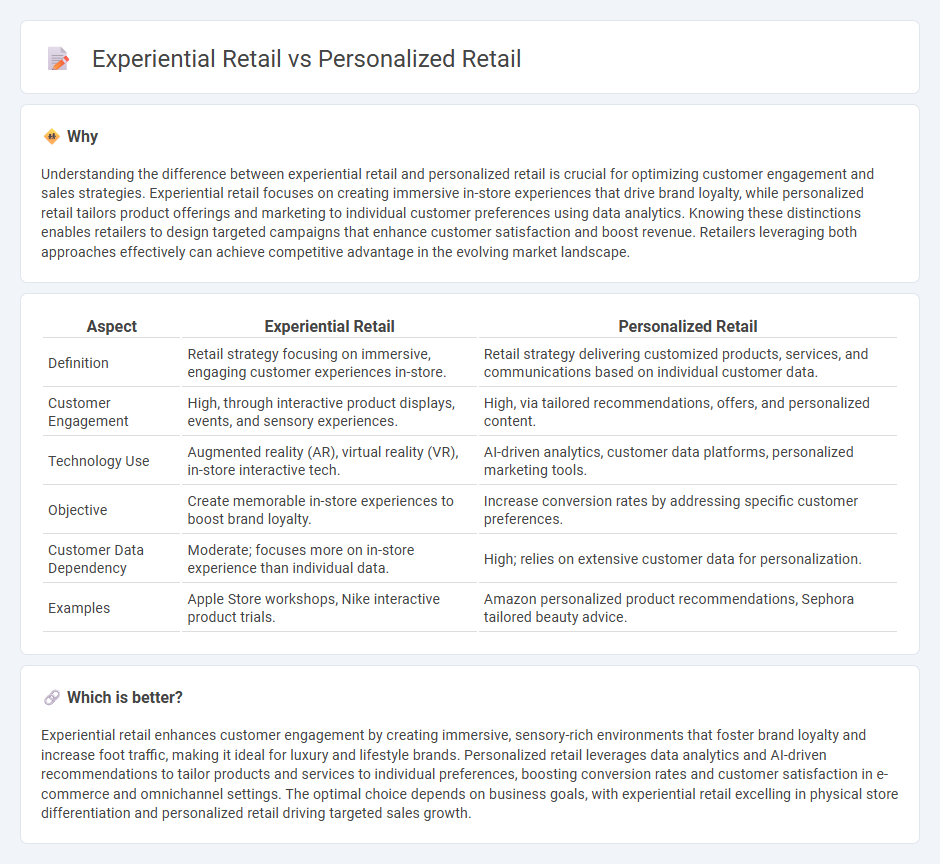
Experiential retail focuses on creating immersive, sensory-rich environments that engage customers beyond traditional shopping by incorporating interactive displays and live events. Personalized retail leverages data analytics and AI to tailor product recommendations, promotions, and shopping experiences to individual preferences and behaviors. Discover how combining these approaches can revolutionize customer engagement and drive sales.
Why it is important
Understanding the difference between experiential retail and personalized retail is crucial for optimizing customer engagement and sales strategies. Experiential retail focuses on creating immersive in-store experiences that drive brand loyalty, while personalized retail tailors product offerings and marketing to individual customer preferences using data analytics. Knowing these distinctions enables retailers to design targeted campaigns that enhance customer satisfaction and boost revenue. Retailers leveraging both approaches effectively can achieve competitive advantage in the evolving market landscape.
Comparison Table
| Aspect | Experiential Retail | Personalized Retail |
|---|---|---|
| Definition | Retail strategy focusing on immersive, engaging customer experiences in-store. | Retail strategy delivering customized products, services, and communications based on individual customer data. |
| Customer Engagement | High, through interactive product displays, events, and sensory experiences. | High, via tailored recommendations, offers, and personalized content. |
| Technology Use | Augmented reality (AR), virtual reality (VR), in-store interactive tech. | AI-driven analytics, customer data platforms, personalized marketing tools. |
| Objective | Create memorable in-store experiences to boost brand loyalty. | Increase conversion rates by addressing specific customer preferences. |
| Customer Data Dependency | Moderate; focuses more on in-store experience than individual data. | High; relies on extensive customer data for personalization. |
| Examples | Apple Store workshops, Nike interactive product trials. | Amazon personalized product recommendations, Sephora tailored beauty advice. |
Which is better?
Experiential retail enhances customer engagement by creating immersive, sensory-rich environments that foster brand loyalty and increase foot traffic, making it ideal for luxury and lifestyle brands. Personalized retail leverages data analytics and AI-driven recommendations to tailor products and services to individual preferences, boosting conversion rates and customer satisfaction in e-commerce and omnichannel settings. The optimal choice depends on business goals, with experiential retail excelling in physical store differentiation and personalized retail driving targeted sales growth.
Connection
Experiential retail enhances personalized retail by creating immersive, tailored shopping environments that engage customers on a sensory and emotional level, fostering stronger brand loyalty. Personalized retail leverages data analytics and customer insights to customize product offerings and experiences, making experiential retail more relevant and impactful. Together, these strategies drive higher customer satisfaction and increased sales by blending personalized service with memorable, interactive store experiences.
Key Terms
Customer segmentation
Personalized retail leverages customer segmentation by analyzing demographic, behavioral, and psychographic data to tailor product recommendations and marketing messages, enhancing individual shopping experiences. Experiential retail segments customers based on lifestyle preferences and engagement patterns, creating immersive environments that foster emotional connections and brand loyalty. Explore how advanced customer segmentation strategies can transform your retail approach and drive sales growth.
Immersive environments
Personalized retail leverages data analytics and AI to create tailored shopping experiences based on individual customer preferences, enabling immersive environments that reflect unique tastes and behaviors. Experiential retail emphasizes creating engaging, multi-sensory store designs that immerse customers in brand stories and interactive experiences, fostering emotional connections and increased dwell time. Explore how combining personalized strategies with immersive retail environments can transform customer engagement and drive sales growth.
Recommendation engines
Recommendation engines in personalized retail leverage customer data and machine learning algorithms to deliver tailored product suggestions, enhancing individual shopping experiences and increasing conversion rates. In experiential retail, these engines integrate with in-store technologies like AR and interactive displays to create immersive, context-aware recommendations that drive engagement. Discover how cutting-edge recommendation systems are transforming both personalized and experiential retail landscapes by boosting customer satisfaction and loyalty.
Source and External Links
Personalization in Retail: Examples & Strategies (2025) - Shopify - Personalized retail uses customer data like browsing and purchase history to offer tailored product recommendations and discounts, creating customized shopping experiences without needing expensive technology.
Personalization in retail -- the complete guide - Retail personalization integrates online and offline customer data to deliver customized experiences through apps, rewards programs, in-store technology, and personalized marketing, exemplified by brands like Best Buy and Nike.
The Rise of Personalized Shopping: How Customization is Changing Retail in 2025 - Retail personalization in 2025 includes AI-powered styling, made-to-measure clothing, monogramming, beauty customization, and interactive in-store technologies that deliver unique, individualized shopping experiences.
 dowidth.com
dowidth.com